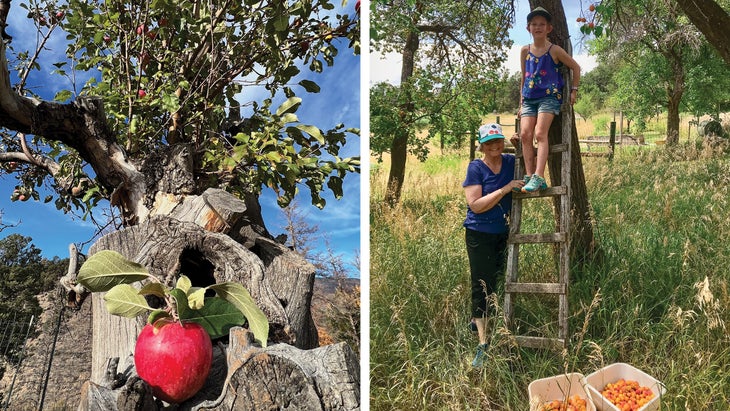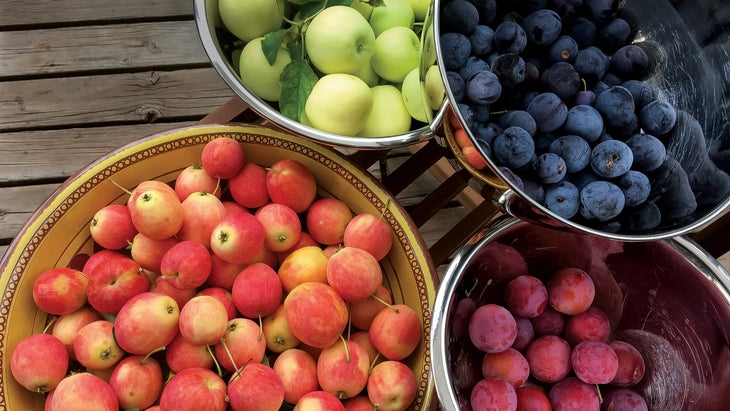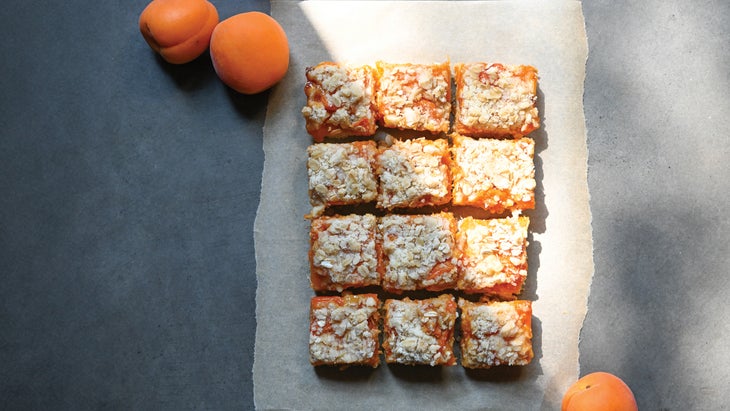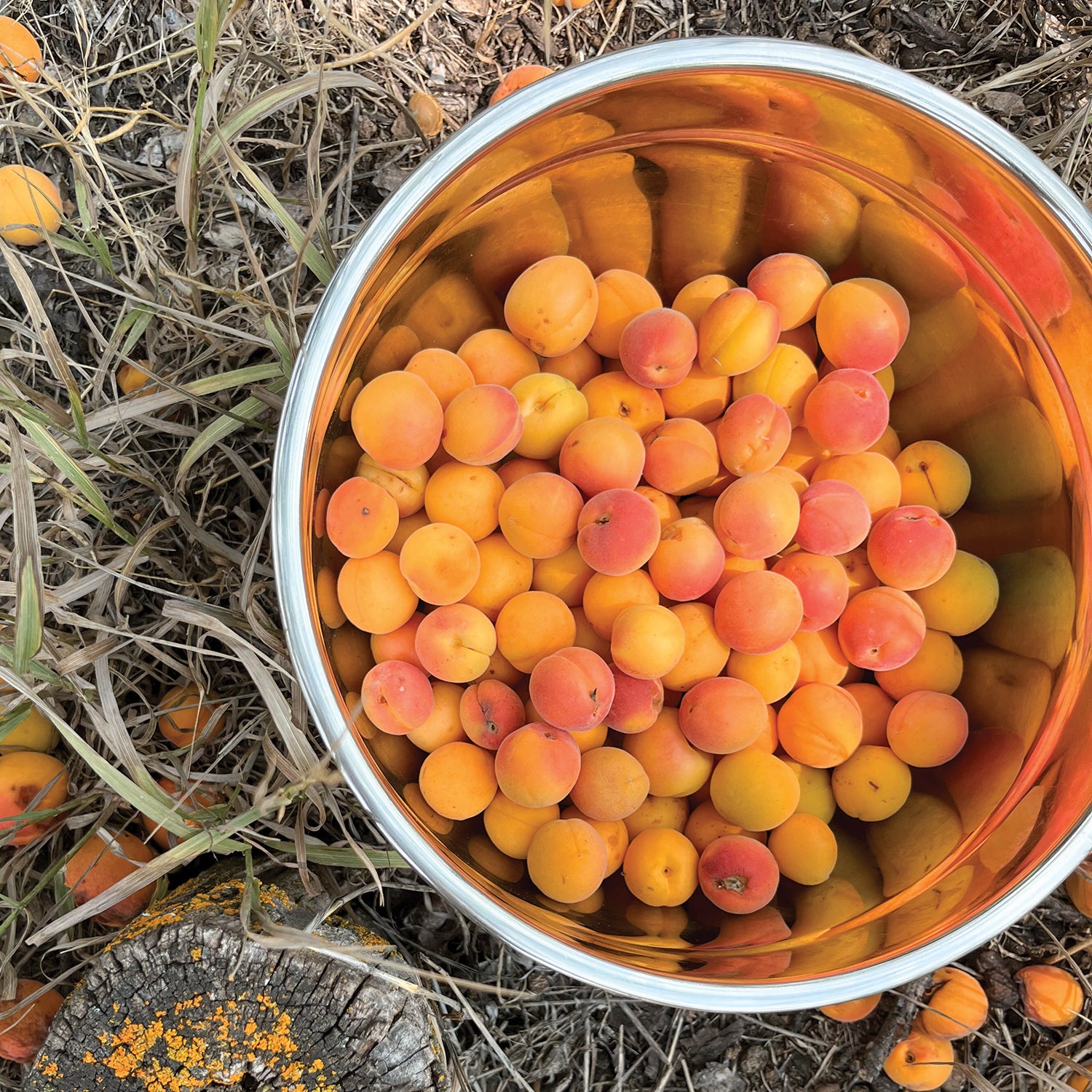At the end of August I get the call. “The apricots are ready,” my mom says excitedly. I grab a few buckets, jump in my car, and drive the 100 or so miles from my home in Dillon, Colorado, to her place in Carbondale. We pile into her Subaru and wind a bit higher into the slopes above the Roaring Fork Valley. We wave as we pass our friends’ house, then park below their orchard, a century-old stand of apricot trees that sits at 6,500 feet.
The 50 trees here are old, and time has gnarled their branches. A weathered wooden ladder reaches into the canopy; the perfumed air reminds us of the jam making and baking that will (happily) occupy our time in the week ahead.
These days, grocery stores sell firm apricots the size of golf balls, but the soft, ripe fruit in these trees are the diameter of a quarter. It takes a while to fill a bucket, but the intense flavors are worth it. Other scavengers are around—birds, deer, even bears—and we give them plenty of space.
This orchard, which contains several apricot varieties, is believed to date back to 1915, and being here makes me think about the people who planted it, and what the trees have endured. Surely, there have been periods of extended drought and extreme cold, and yet, year after year, they continue to bring forth treasures.
“Fruit trees watch several generations go by,” says Michael Thompson, who, along with Jerome Osentowski, cofounded an organization called the , a nonprofit that maps and catalogs ancient specimens like these all over the valley.

Great old trees are not unique to Colorado or the West, of course. They dot the nation, languishing in plain sight in forgotten corners of cities and towns, and across rolling farmland. But in recent years—spurred by a renewed interest in things with rich stories and heritage behind them—there’s been a movement not just to save old trees but to propagate them for the future.
In New York City, Sam Van Aken, an artist turned farmer, planted a permanent heirloom “exhibition” on Governors Island called . The public site opened in 2022; the 102 specimens it comprises are grafted from trees—apricots, apples, pears, persimmons, cherries, and others—that once thrived across the city’s five boroughs. In total, they represent about 400 years of local agriculture.
Although most Americans get by with the fruit they find piled in grocery bins, that represents only the tiniest slice of what once freely bloomed. Take the apple. Our commercial, homogenized food system promotes varieties like the crisp but boring Fuji and Granny Smith because they are easily grown, universally accepted, and hardy enough to transport and store.
“There were once thousands of cultivated apple varieties, and now we’re down to hundreds,” says Vanessa Harmony, a tree propagator and the owner of Colorado Edible Forest in Glenwood Springs, which works in tandem with the Heritage Fruit Tree Project. “There are so many delicious fruits that could be lost if they’re not found,” she says.
That’s the role of organizations like ; Washington State University’s MyFruitTree, which works only with apples; and regional entities like Thompson’s Heritage Fruit Tree Project. Indexing each heirloom’s type, location, approximate age, fruit characteristics, and site history culminates in a written log and map of agricultural diversity. This information helps when experts are grafting clones to ensure that varieties aren’t lost to time.
Like Open Orchard in New York, Harmony, Thompson, and Osentowski have had a hand in creating a research site filled with fruit trees. The parcel, established in 2020, sits within an old orchard in Emma, Colorado, outside Basalt. It’s open to the public and will eventually feature informational placards, so visitors know what they’re looking at. Harmony helps maintain the old trees and the newly planted clones gathered from around the valley. “It’s become a living library for me,” she says.

Observing the trees through the seasons means Harmony can identify desired qualities—whether it’s the best-tasting fruit, tree hardiness, or something else. She can also send leaf samples out for genetic testing to determine exactly what kind of tree she’s dealing with. Sometimes that information yields an entirely new variety—or, rather, one so old that no one around today knew about it.
Thompson enlisted Harmony’s help with his favorite: a grand old apple tree he affectionately calls Mo. It was planted in 1910 and produces what Thompson considers the best apple he’s ever found for pie making. In recent years, this magnificent tree has suffered from blight, and even with thoughtful pruning its future is in question. Harmony has already grafted multiple clones from healthy parts of the tree. Those “Mini Mos”—two of which are planted in Thompson’s daughter’s backyard in Oregon, and two of which are doing well at Harmony’s nursery—are the next generation. “The tree will live on,” he says.
As for the apricots that leave my mom’s and my hands sticky with juice, our friends have largely let nature take its course. In the thirtyish years they have owned the property, Susy Ellison says they’ve had the orchard pruned only a couple of times. The trees, she tells me, seem to like being left alone. “You don’t want to fuss with them too much,” she explains, adding that they’ve been cataloged by the Heritage Fruit Tree Project.
We gather our buckets and load them into the car. As soon as we close the doors, we’re enveloped by the thick and heady scent of apricots. We wave again as we pass the house and drive straight to my mom’s. There’s jam to be made.
Fruit Forward: Interest in Heritage Fruit Has Blossomed
Although the Heritage Fruit Tree Project is specific to Colorado’s Roaring Fork Valley, there are other organizations doing similar work around the country.
The biggest among these is the Historic Fruit Tree Working Group of North America. The serves as a national database and registry of historic trees and orchards.
Anyone interested in heirloom fruit, especially apples, should sign up for the University of Idaho Heritage Orchard Conference. The free monthly webinars are packed with info on subjects ranging from cider making to tree propagation.
New Yorkers (and those just visiting) can check out Open Orchard on Governors Island, where approximately 100 trees represent the bounty that once grew in the city’s five boroughs.
The and the are based in southwestern and western Colorado, respectively, and focus almost exclusively on apples. Both are intent on saving orchard culture as well as legacy genetics.
Apricot Snack Bars

There are a million and one jam-bar recipes out there, and this is mine—except that I use fresh fruit instead of preserves. The recipe works equally well with fresh and frozen apricots; you can also swap in seasonal berries or peaches and plums. What makes the treats so irresistible is the sweet-tart play of crust and fruit.
Makes about 12 bars
For the Filling:
- 3 cups apricots, halved or
quartered, depending on size - ¼ cup sugar
- ½ lemon, juiced
- 2 tsp cornstarch
For the Crust:
- 1½ cups flour
- ½ cup old-fashioned oats
- ½ cup sugar
- ½ tsp baking powder
- ½ tsp salt
- ½ cup unsalted butter, chilled
- ⅓ cup full-fat plain yogurt
Prepare the filling by combining apricots, sugar, and lemon juice in a medium bowl. Set aside and allow to macerate at room temperature. (This step can be done in advance.) If fruit is frozen, allow it to thaw before macerating.
Preheat oven to 375 degrees. Butter an eight-inch square baking pan.
Prepare the crust by stirring together flour, oats, sugar, baking powder, and salt in a medium bowl. Cube butter and add to flour mixture. Use your fingers to smear and incorporate the butter into the flour mixture. Add yogurt and stir. The mixture should be dry.
Add about 1½ cups of this crust mixture to the prepared pan, or enough to cover the bottom evenly. Press mixture down with fingers or use the base of a measuring cup until firm. Press a square of parchment paper onto the surface of the crust and then add pie weights (you can also use dried beans or rice). Par-bake for 12 minutes, until set but still soft. Carefully remove parchment and weights.
Stir cornstarch into the apricots. Pour apricot mixture over crust. Sprinkle with remaining crust mixture. Bake for 40 to 45 minutes, or until top is golden brown and fruit is bubbling. Remove from the oven, allow to cool, then cut into squares.

Amanda M. Faison, a writer and editor based in Colorado, is working on her first cookbook.


